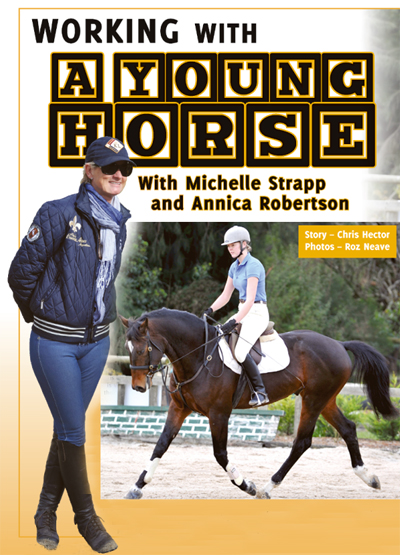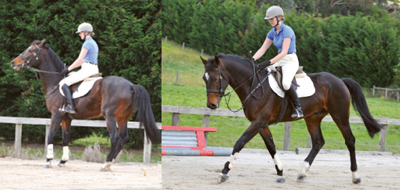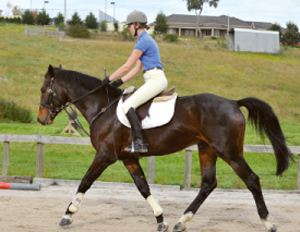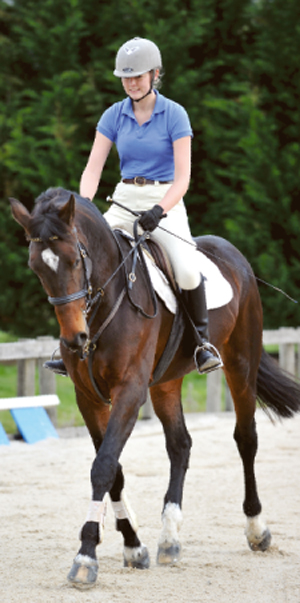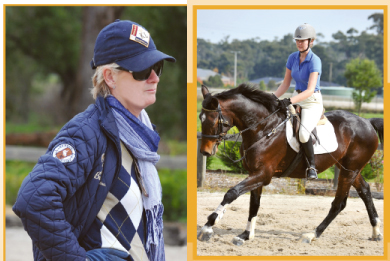This story started out as a jumping ‘how to’ with Michelle Strapp and her exciting young pupil, Annica Robertson. In our earlier feature, Annica rode her sixteen year old Thoroughbred, Tenterfield, this time it was a very different ride, a four year old, very green youngster, Kermit, a Warmblood Stallion by Balou du Rouet.
We got the story sure enough, but far from it being a specialized piece for our jumping fans, it is a brilliant exposition of how to warm up, how to ride and balance, a baby. It doesn’t matter if your goal is dressage, or eventing, or just a nice riding horse, this is essential reading…
Michelle saw the young horse as a valuable next step for Annica in her equestrian education.
“He’s a four year old that has only been broken in about six months ago. This is the first young horse that Annica has started from the beginning. This is all about her understanding the process of developing young horses and the important things to focus on – like the separation of the aids. She has to understand what is going on, she might ride a line and say ‘oh he feels long’ or ‘he is drifting left’ or ‘he is behind the leg’, what I try to do is get her to recognize where the main issues are, and what she can correct and what she has to blend with.”
“She has to recognize that he is a really sweet horse, very sensitive. We haven’t seen what he is like over a jump because we haven’t jumped him loose or jumped him on the lunge.”
“I think one of the hardest things for someone like Annica trying to learn how to ride a baby horse is learning how to produce a canter that is good enough to jump a fence. It is that art of blending the half halt so it is effective and keeps the canter going, without jamming the horse up, and that takes feel. It is very easy to say, produce a canter to jump this fence, and then these young riders start riding off their horses’ heads. At the moment all we are trying to do is get her to understand what is involved in travelling in a nice rhythm, to teach him a half halt, to try and get her the feeling of having him more over the back and taking rein.”
The lesson begins, and right from the start, Michelle demonstrates one of the great qualities of any trainer, the ability to adapt, to listen to what the horse is telling you…
“Start at the trot rather than the walk because he is holding himself, can you feel that?”
I make the observation that he is grabbing a little at the bit…
“Because he doesn’t have a true contact. He’s got the typical mouth of a horse that has just been broken in, the hand means stop – that’s all. That’s why I get her to go forward rather than stay in the walk.”
How quick it changes, he is in a nice contact now…
“Yes, as we warm up, then he will start to take the walk. So if I see that picture where he is sucking back in the hand, get him moving forward, not to stay at the walk and start fiddling at the walk. It’s very hard to fix that problem at the walk because the only reason he is grabbing at the bit at the walk is because he is behind the leg. He is sucking back and not really taking the rein. Once he is going forward you can see he comes to a nice contact.”
And he has got a pleasant trot…
“Lovely, it is elevated, and he is starting to get very happy in his work. At the trot we used to have the same problems with his mouth, so you can see we are getting somewhere. Which way is he pushing you Annica?”
“To the left.”
“Okay so a little bit of right opening rein, don’t pull your left rein over the neck.”
He’s pushing to the inside…
“His right hind leg is pushing in, but his left shoulder is pushing out. This is the way he likes to be, a bit on two tracks with his left fore out and his right hind in, like a banana. So what I really concentrate on when I am trying to teach a rider to get a young horse to travel, is that they get both sides of the horse’s body working at the same length: the right side goes totally even to the right side of the bit, and the left side is even to the left side of the bit, I don’t concentrate on neck bend at all. I don’t encourage it. I’d like both ears to be level, and for Annica to think about her sternum going straight up her horse’s crest, so she could feel he wanted to throw his weight to the left, and she corrected that.”
“Remember when you correct the lateral balance, when he starts to throw his weight over, you’ve also got to correct the longitudinal balance. How did we do that yesterday?”
“Slowing down the rise…”
“Yes, perfect. Slow the rise, it’s a half halt. Annica doesn’t need a half halt in her hand because the horse isn’t pushing at the bit, but when a horse drifts left or right, it is obviously on the forehand, they are obviously running out of balance, so I teach her to slow her rise down to get the horse to just sit for a minute, and it is much easier to control your lateral balance if the horse is sitting. He is still very green and wobbly at this stage.”
“It is the same when you jump, if you teach the rider at this level, a correct balance with their upper body, it is going to be natural coming to a distance, when a horse starts to run past the distance, or you have a short distance, that the rider’s automatic reaction is going to be body not hand. So when Annica feels the horse go out of balance, I like it when she just slows the rise – sometimes with a horse that is more pushy than him, then I’d go to sitting trot, but he is not pushy so she doesn’t need to sit. Slowing the rise just makes the half transition…”
“At this stage his canter is just big, Annica is working on getting the feeling of teaching him a half halt at the canter but we started getting the feel of the half halt at the trot. Keep the neck really really straight so that he is even to two reins, keep your eyes up, and now slow your rise to shorten the trot, feel the beat fall away?”
“Yeah.”
“Then you change your mind and stay there. When the beat fell away, the inconsistent contact with the bit came – it is the same as waiting to a distance on the approach to the fence, you want the power to come into the hand even though the horse waits. You may go to slow your rise for a half halt, but when you feel that the power on the beat of your trot falls away, change your mind!”
“Yesterday coming down the long side we started to teach him to move off your left leg, so do it again, two or three steps off the left hind, good girl – steady hands, very steady hands, straight and forward again. Now follow the bridle for a stride and see if he takes it – take it back and right (inside) opening rein because he is lugging towards the in gate but don’t tighten your left (outside) hand when you do that, ride the turn with your eyes and your legs and just guide him with a right opening rein. You can’t lock up on your left rein when he bulges left otherwise you are locking him up. Freely open the right rein and show him where you want to go… better. If you pull your left rein harder, he’ll just think you mean turn left.”
“Do it again, right opening rein, show him where you want to go, take his nose a little – beautiful. See, now you don’t have the same resistance but if you lock the door with the left rein, he is going to be very confused. Just think of your reins guiding him, not strangling him – guide him in the line you want to go. Now let’s change rein…”
“Now this way, because the horse on the right rein falls with the left shoulder to the outside, this way, he falls in. Left opening rein, very nice, now forward and straight. Increase the trot. Now if he feels like he is falling to the left at the top of the arena, slow your rise. Now let’s teach him to respond with the left hind leg. Walk transition, keep him straight to the corner, just halt there, and turn on the forehand. Change your whip over. Okay left hind leg, open your left rein, keep it simple, left hind, left hind, beautiful – trot straight. Think trot before you worry about where his head is. The only reason he is above the bridle is that he is thinking backwards, keep your hands steady… I think he’s got his tongue over the bit, let me check.”
“He was trying to get his tongue over the bit, it is a stage they get into…”
Ulf Möller would say, no drop nose band, you are asking him to do that…
“He needs a drop nose band for sure, but the owner of the horse is not happy with him being ridden in a drop nose band, so…”
“Good now he is off your left leg, now follow with two reins, nice. The give is getting better, see how soft Annica is riding (Do I need to point out to the anti drop nose band brigade, that there is no contradiction between using a drop nose band and giving the horse the rein, Ulf Möller is always asking his riders to give, give, give – he just doesn’t want the horse to start fiddling with the bit and find it can put its tongue over it.) Give, give again, lovely good girl, you are really getting that elastic feel with your arm – your arms are starting to be a continuation of the contact. Lovely give again, super, that is really nice. Just open the rein when he gets a little mouthy. It is important that you don’t over-react to that, just keep a nice elastic feel.”
“Left opening rein, let’s ride a circle. Lovely now give. Left opening rein again, keep your eyes up, now give. Take the feel back, as you take it back, make sure it is really smooth. Left opening rein. Good. Now test your driving aid, test the go button – see if he responds to your leg. Don’t tighten your arm, just put your leg on. Super – even though he ran, you got the reaction you wanted, so he understands. Put your reins in one hand and give him a pat.”
“Change rein across the diagonal. Keep your elbows really elastic, every time you rise, your elbows should open and shut. Keep that left arm really soft. Straight, beautiful, now he is getting straighter in the neck, now follow.”
And the result is truly lovely… the horse is forward, stretching and soft through the body, this has been a wonderful demonstration of how to warm a horse up… any horse, any discipline.
“Now he is starting to find his own balance. Horses can only strengthen up when they find their own balance, if you are carrying the horse then you will create a tight muscle and a muscle can only strengthen up if you get oxygen to it. A muscle has to be soft that is why it is important that the rider is elastic.”
At this point I remarked to Michelle just how much work was involved in getting a young horse going… This is a very nice, naturally balanced, sweet moving horse, and yet how many hours of this work is it going to need…
“It’s crazy, but the only thing I have always known is that if you take your time in the beginning, it is amazing how fast it goes from then on, but you are right, at this stage, this is the work that has to be consolidated. Day in, day out, until it is really solid. You can’t say, I’ve done two days of this, now it is time to go jumping.”
“Prepare to walk, keep your hands nice and elastic. You have to step into the walk, just use your voice. Super. Walk him for a few minutes then we’ll have a canter.”
“I like to see that a horse has got two gears at the canter before you jump, otherwise, if you have only got one gear, then you are desperate to take whatever distance you see, which is not going to really be producing the balance in the jump. Once you have two gears then at least you have some adjustability.”
“As you ask the canter it is a right opening rein to show him where you want to go. Don’t complicate the transition, just think forward and straight. Soft, soft, soft. No faster, no faster, come off his back now for a few strides, feel the right opening rein and let’s come onto a circle. Try and think a little slower, look where you are going, opening rein, think your line, your line is your priority – look straight ahead and ride a straight line. Come out of the saddle again, try and encourage him – don’t force him, – try and encourage him to be more over the back, but don’t try and force it because you don’t have enough motor behind you to back it up, just encourage it, that is what feel is about.”
“On the circle, right opening rein will help, bring your shoulder slightly to the right, that will help you get him more over the back, slightly to the right, good now give… and take it back again. Shoulder to the right, and get his shoulders right underneath you, right opening rein, just feel the corners of his mouth, perfect, just feel it, now give. That is a fine line you have to learn. Open the rein and forward, forward, forward, don’t chase him with your shoulders, don’t chase him with the bit, keep your hands very steady, it is leg to hand. Go straight and follow.”
“He’s a little fine in the mouth today. I don’t really like that bit – he needs a big fat German snaffle. That bit is a little thin and tight and I think after a couple of days, he is just a little offended by it. I much prefer the German loose ring snaffle with more thickness about it. He needs to be more confident to go to the bit, at this stage I would rather him a fraction more pushy at the bit, then you have got something to half halt, at the moment Annica’s got nothing to half halt because he is a little too fine on it. The last thing you want to do is half halt and he learns to sit behind you and then he is broken in his back…”
No, no, that’s ‘lovely and light’ – that’s what all the people who write to Horsetalk say you should feel…
“No, that is false feel, you really want them a little pushy so you feel the hind leg push to the bit, and then that feels good because then you can actually sit and shorten the canter, but at the moment, you can see he’s too light in the bit and if she shortens too much, he’ll end up going backwards. See now, that is great, both reins are even, Annica is sitting straight, outside rein is higher than the inside one, she is not pulling on the inside rein – I really don’t like a lot of neck bending on these young horses, a lot of people think about bending the neck but they have no control of the four corners. I try and teach my students to think about all four corners of the horse. At this stage if the horse is forward and the hind legs are following the front legs and you have some feel, then generally, your horse will always travel into a good frame – it’s not that the horse wants to be inverted, we just have to show them the way.”
“Annica has done a really good job with this horse. When she started he just used to run and rush, she has a feel for what it takes to start producing a few babies now, it has really helped her riding. You have to think, and it really helps your feel when you ride a baby horse, because a baby horse doesn’t take you anywhere. You can’t pull the shape in with a baby, if you pull the shape in, then they start jacking up, because you’ve shut the front door.”
“He is still trying to push his left barrel in to the left, you can always tell if the rider hasn’t pushed the horse off their left leg, because when you look at the bit, there is a little more of it to be seen on the left hand side. Little by little Annica has to teach him to engage his left hind leg a tiny bit more – good, now give the left rein. Do it again, a little engage of the left hind and then give, beautiful. Every time you feel that you want to tighten up to the left hand side, understand that is because he is pushing his barrel at you. In a really nice way, you slow the rise and teach him what your left leg means. Beautiful, now give, super, now your bit has evened up, that’s why I got you to give left because the left side of the bit was a little further through.”
“Because he is shy of the bit today, when you canter you are going to have to have a better feel. You have to be very very smooth with your hands. You are not looking for the perfect canter transition, just that he floats into the canter from the trot. Really think of the transition as being very much from your leg, the cluck, and just a guiding rein, and don’t over-react to him. Good, very smooth.”
“Now at the canter you’ve just got to think that you don’t lose his outside shoulder in the turn, open the rein and think about the shoulders. Now you’ve got to encourage a slightly rounder horse, more over the back without stopping the canter. Concentrate on that straightness, just a light feel.”
“Now a large circle. Lead him into the circle, look to the line with your eyes. Now come off his back, there’s freedom in the back, he thought about a little buck… good. As you bring your angle back, you will find he’ll slow his motor down so be ready with a cluck.”
And of course he trots…
“Young horses are so predictable, left opening rein, try again. Lovely, now out of the saddle again and gradually bring your angle back with a cluck, good. Down the long side, out of the saddle again, smooth hands, and see now he is starting to come over the back, go for a little gallop now, but remember when you come back to come very gradually back because he is not going to be capable of coming suddenly back, good now go into your circle…”
“She is a good girl, she tries hard. Out of the saddle again, stay there, and only use your voice to come to the trot. Let him find his own balance to come back. Super. Walk transition, just your voice, lovely, give him a long rein and a pat.”
Annica – riding a young horse
It is a very different ride from your ‘red head’ Thoroughbred…
“Very very different, basically because he is a Warmblood, but also because he is so young. He hasn’t picked up any bad habits because we’ve started from scratch with him, it’s different but it is also good because I can mould him into whatever I want him to be.”
Different riding skills?
“It’s a lot harder than I expected it to be – there are so many things that you don’t even have to think about with an older horse… you have to be so careful what you do, with your leg aids and with your rein aids, but I’ve really really enjoyed it.”

